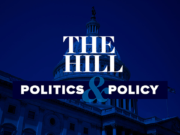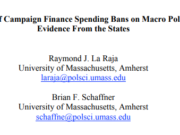The following post is adapted from my 2012 essay, “Spending and Amending: The Past and Future of Citizens United.” It evaluates four major predictions, identified in “Back to the Future? The Effects of Citizens United v. FEC in the 2010 Election,” by Peter L. Francia, that motivate would-be “reformers” of Citizens United. Taken together, these four predictions comprise the usual “case against Citizens United.” In this series of five posts, I evaluate each prediction and examine whether or not each was supported by data from the 2010 midterm elections. The fifth and final post draws conclusions from the data I have examined. You can read parts one, two, four, and five at these links.
Prediction 3: The Citizens United ruling would provide Republicans with an advantage over Democrats. In the days just before the ruling, Senator Menendez (D-NJ) stated of a Citizens United victory that, “clearly, the Republican Party overwhelmingly would benefit.”
The third charge that “reformers” have made against Citizens United is that the decision was the result of a supposedly “conservative” Court helping conservative groups gain a competitive electoral advantage by allowing sympathetic corporate interests to donate and advertise more. “Reformers” worried that corporate and pro-business interests would disproportionately throw their considerable financial weight behind Republican candidates, creating a competitive imbalance that might determine elections.
At first glance, there seems to be some early support for this prediction. Conservative groups spent $119.7 million in support of Republican candidates in 2008. That number jumped up to $190.5 million in 2010. The increase is even more dramatic if we use 2006, the previous midterm election, as a baseline. In 2006, independent conservative groups only spent $19.6 million. In fact, liberal groups went from outspending conservative groups by roughly $20 million in 2006, to being outspent by roughly $90 million in 2010. This is clearly a dramatic change, and Citizens United seems to be the most likely culprit.
However, as always, there is more to the story. Spending totals seem to be heavily influenced by the enthusiasm and prospect of victory perceived by each side. In 2006, a year that saw a hapless Republican party soundly defeated by an energized Democratic base, conservative groups only spent $19.6 million, but they spent $68.5 million in 2004 and $119.7 million in 2008. This indicates that the amount spent is very much determined by the nature of the election. The more enthusiastic one side is about its chances for electoral success, the more that side spends. Donors are more interested in opening their checkbooks when they foresee a real chance of success. The prospect of victory influences spending at least as much as spending influences electoral victory.
In addition, independent spending has been steadily increasing for years, and the rate of increase has accelerated as well. Liberal groups have at least doubled their previous spending total in every midterm election since 1998. Without the influence of Citizens United, independent liberal interest groups went from spending $30.2 million in 2000 to spending $121.3 million in 2004, figures that aren’t too far off from the increase that Republicans enjoyed in 2010. In other words, Republicans have never had a monopoly on independent spending. As I have discussed, 2010 was a good year to be a Republican congressional candidate and a great year to be a conservative interest group. In opposite circumstances, liberal groups could likely marshal their resources to outspend conservative groups in similarly dramatic fashion.
According to Francia, the “2010 election cycle…was especially promising for Republican candidates as numerous polls revealed an ‘enthusiasm gap’ among likely voters that heavily favored the Republican Party,” which “undoubtedly translated” into the consequent spending gap. Also, in 2010 “it was widely reported that the Republican National Committee was in financial trouble,” which may have prompted conservative groups to pick up the slack, or prompted donors to give more to interest groups rather than the troubled Republican organization. Finally, Francia notes that conservative groups were simply “much better coordinated in their efforts in 2010 than in previous election cycles,” after adopting the development strategies of successful liberal organizations. Without these factors, which were unique to the 2010 election cycle, conservative groups probably wouldn’t have outpaced the baseline inflationary trend in independent spending in 2010.
In terms of total political advertising, by both interest groups and candidates/parties, Democrats actually enjoyed a steadily increasing advantage from late September through Election Day in 2010. From this perspective, it is clear that Republican advertisers were a far cry from “drowning out” the voices of their adversaries. “If anything,” Franz says, “pro-Republican groups helped keep Republican challengers competitive with the incumbent Democratic class.” Far from outspending Democrats, conservative groups essentially narrowed the large advertising deficit that Republicans would have faced otherwise.
Citizens United actually fostered a more equal competitive balance between Republicans and Democrats (in 2010 at least). So, Citizens United may have afforded Republicans a relative advantage in advertising, compared to the level of disadvantage they faced previously, but it still did not give Republicans an absolute advantage, as they were still outspent by Democrats and their supporters. If “reformers” wish to use fairness or competitive balance as part of their case for an amendment, they will have to show why Republicans ought to be at an advertising disadvantage, and why citizen groups’ mitigation of that disadvantage is objectively bad.
Thomas E. Mann of the liberal-leaning Brookings Institute says, “Citizens United was probably not crucial for the 2010 midterm election outcome. I make no argument that too much money was spent, or that it was disproportionately mobilized by corporate interests favoring the Republican party.” Mann places far more stock in “large forces,” citing “an economic referendum, and a radically shrunken and restructured electorate.” He also agrees that “there was, indeed, a rough balance of resources between the parties. Sometimes the outside groups ended up evening what would have otherwise been an advantage for the Democrats.” Nor does he complain about the vast sums of money Republicans “threw away” on losing campaigns. In the final analysis, Mann says “any fair minded social science analysis of this election would say the…balance or imbalance of resources was a relatively minor factor in the outcome of the [2010] election.”
Next topic: Did Citizens United open the door to foreign corporations to influence our elections?














